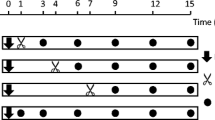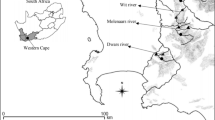Abstract
The effects of foliar- and root-feeding insects on the dynamics of an early successional plant community, representing the first four years of colonisation, were examined. Subterranean insect herbivores were found to increase in density with increasing successional age of the plant community. In early succession, chewing insects mainly Coleoptera (Scarabaeidae) and Diptera (Tipulidae) were dominant. This was in direct contrast to the foliar-feeding insects, which were dominated by sap-feeders (mainly Auchenorrhynchan Hemiptera).
Reduction of both foliar- and root-feeding insects with appropriate insecticides had different, but dramatic, consequences for the plant community. Reducing foliar herbivory resulted in large increases in perennial grass growth, with plant species richness being reduced as the grasses outcompeted the forbs. Reducing subterranean herbivory prolonged the persistence of annual forbs, greatly increased perennial forb colonisation and, as a consequence, plant species richness. Foliar-feeding insects thus act to delay succession by slowing grass colonisation. In contrast, root-feeding insects accelerate succession by reducing forb persistence and colonisation. The structure of early successional plant communities is therefore modified by the two modes of herbivory.
Similar content being viewed by others
References
Bakker, J. P., de, Leeuw, J. & van, Wieren, S. E. 1987. Micropatterns in grassland vegetation created and substained by sheep grazing. Vegetatio 55: 153–161.
Brown, V. K. 1990. Insect herbivory and its effect on plant succession. In: Burdon, J. J. & Leather, S. R. (eds.), Pests, pathogens and plant communities, pp. 275–288. Blackwell, Oxford.
Brown, V. K. & Gange, A. C. 1989a. Differential effects of above-and below-ground insect herbivory during early plant succession. Oikos 54: 67–76.
Brown, V. K. & Gange, A. C. 1989b. Herbivory by soildwelling insects depresses plant species richness. Funct. Ecol. 3: 667–671.
Brown, V. K. & Gange, A. C. 1990. Insect herbivory below ground. Adv. Ecol. Res. 20: 1–58.
Brown, V. K. & Hyman, P. S. 1986. Successional communities of plants and phytophagous Coleoptera. J. Ecol. 74: 963–975.
Brown, V. K., Jepsen, M. & Gibson, C. W. D. 1988. Insect herbivory: effects on early old field succession demonstrated by chemical exclusion methods. Oikos 52: 293–302.
Brown, V. K. & Southwood, T. R. E. 1987. Secondary succession: patterns and strategies. In: Gray, A. J., Crawley, M. J. & Edwards, P. J. (eds.), Colonization, succession and stability, pp. 315–338. Blackwell, Oxford.
Clements, R. O., Bentley, B. R. & Nuttall, R. M. 1987. The invertebrate population and response to pesticide treatment of two permanent and two temporary pastures. Ann. Appl. Biol. 111: 399–407.
East, R. & Willoughby, B. E. 1983. Grass grub (Costelytra zealandica) population collapse in the northern North Island. N.Z.J. Agric. Res. 26: 381–390.
Edwards, C. A. & Fletcher, K. E. 1971. A comparison of extraction methods for terrestrial arthropods. In: Phillipson, J. (ed) Methods of study in quantitative soil ecology: population, production and energy flow, pp. 150–185. Blackwell, Oxford.
Edwards-Jones, G. 1988. Insect herbivore load and plant succession. Ph.D. thesis, University of London.
Evans, E. W. 1990. Experimental manipulation of herbivores in native tallgrass prairie: responses of aboveground arthropods. Am. Midl. Nat. 125: 37–46.
Franklin, J. F. 1989. Importance and justification of long-term studies in ecology. In: Likens, G. E. (ed), Long-term studies in ecology. Approaches and alternatives, pp. 3–19. Springer-Verlag, New York.
Gange, A. C., Brown, V. K., Barlow, G. S., Whitehouse, D. M. & Moreton, R. J. 1991. Spatial distribution of garden chafer larvae in a golf tee. J. Sports Turf Res. Inst. (67: 8–13).
Gange, A. C., Brown, V. K. & Farmes, L. M. 1991. Mechanisms of seedling mortality by subterranean insect herbivores. Oecologia 88: 228–232.
Gibson, C. W. D., Brown, V. K. & Jepsen, M. 1987. Relationships between the effects of insect herbivory and sheep grazing on seasonal changes in an early successional plant community. Oecologia 71: 245–253.
Gibson, D. J., Freeman, C. C. & Hulbert, L. C. 1990. Effects of small mammal and invertebrate herbivory on plant species richness and abundance in tallgrass prairie. Oecologia 84: 169–175.
Grubb, P. J. 1977. The maintenance of species-richness in plant communities: the importance of the regeneration niche. Biol. Rev. 52: 107–145.
Harper, J. L. 1977. Population Biology of Plants. Academic Press, London.
Hendrix, S. D., Brown, V. K. & Dingle, H. 1988. Arthropod guild structure during early old field succession in a new and old world site. J. Anim. Ecol. 57: 1053–1065.
Kinsman, S. & Platt, W. J. 1984. The impact of a herbivore upon Mirabilis hirsuta, a fugitive prairie plant. Oecologia 65: 2–6.
Lawton, J. H. & Strong, D. R. 1981. Community patterns and competition in folivorous insects. Am. Nat. 118: 317–338.
Louda, S. M. 1982. Limitation of the recruitment of the shrub Haplopappus squarrosus (Asteraceae) by flower-feeding and seed-feeding insects. J. Ecol. 70: 43–54.
Martin, H. & Worthing, C. R. 1976. Insecticide and Fungicide Handbook. Blackwell, Oxford.
Paul, N. D., Ayres, P. G. & Wyness, L. E. 1989. On the use of fungicides for experimentation in natural vegetation. Funct. Ecol. 3: 759–769.
Prins, A. H. & Nell, H. W. 1990. Positive and negative effects of herbivory on the population dynamics of Senecio jacobaea L. and Cynoglossum officinale L. Oecologia 83: 325–332.
Root, R. B. 1973. Organisation of a plant arthropod association in simple and diverse habitats: the fauna of collards (Brassica oleracea). Ecol. Mon. 43: 95–124.
Southwood, T. R. E., Brown, V. K. & Reader, P. M. 1979. The relationships of plant and insect diversities in succession. Biol. J. Linn. Soc. 12: 327–348.
Waloff, N. 1980. Studies of grassland leaf-hoppers and their natural enemies. Adv. Ecol. Res. 11: 82–215.
Author information
Authors and Affiliations
Rights and permissions
About this article
Cite this article
Brown, V.K., Gange, A.C. Secondary plant succession: how is it modified by insect herbivory?. Vegetatio 101, 3–13 (1992). https://doi.org/10.1007/BF00031910
Accepted:
Issue Date:
DOI: https://doi.org/10.1007/BF00031910




